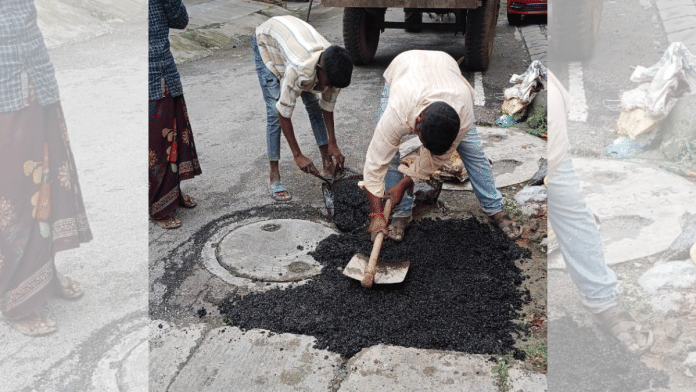Bengaluru: Civic negligence claimed at least 20 lives in India’s IT capital in 2023, keeping Bengaluru in the dubious company of Indian cities with the most unsafe public infrastructure for the fourth consecutive year. Trailing Bengaluru is Indore in Madhya Pradesh with two deaths attributed to negligence by civic bodies that year, followed by Ghaziabad with one. While latest data from the National Crime Records Bureau (NCRB) corresponds to deaths in 2023, the situation on the ground here has not improved since.
NCRB data shows that Bengaluru recorded 21 deaths attributed to civic negligence in 2022, 31 the previous year and 49 in 2019.
The NCRB reports do not specify the circumstances around the 20 deaths recorded in 2023. But ask residents, opposition leaders, or civil society, and they will point to roads lined with potholes as the most stark example of Bengaluru’s descent into urban ruin.
Earlier this week, a 20-year-old student was run over by a truck in the northern part of the city. She was on her way to college when the truck collided with her two-wheeler. Going by some eyewitness accounts, she was trying to avoid a pothole when the accident took place.
Responding to questions about civic negligence taking a fatal turn, Deputy Chief Minister D.K. Shivakumar, who also holds the Bengaluru Development portfolio, said in a statement issued Wednesday, “Our team is working round the clock to ensure the best for Namma Bengaluru. We have asked all our commissioners to be on the field, listening to people, taking swift and effective actions.”
While the Congress returned to power in the state in May 2023, Bengaluru’s current state is a result of decades of neglect, corruption, and insufficient planning. This, in turn, led to poor quality of public infrastructure, encroachment of open spaces and natural canals that causes flooding even at the slightest hint of rain, and other challenges that have overshadowed the city’s reputation as a global hub for information technology, aviation, startups and biotechnology, among other sectors.
In May, the Siddaramaiah-led Congress government officially established the Greater Bengaluru Authority (GBA) to replace the Bruhat Bengaluru Mahanagara Pablike (BBMP). The GBA will function through five municipal corporations. The jurisdiction of each municipal corporation will be divided into two zones. The idea was to divide the city of 84.99 lakh residents into smaller corporations for more effective governance.
Under a notification issued Tuesday, the number of wards, too, have been increased to 368 from the earlier 198, with each covering a population of about 40,000 on average. Elections to the municipal council were last held five years ago, in September 2020, leaving all matters of administration with the state government or officials.
As Ashwin Mahesh, an urban planner, wrote in a post on X: “The problem with urban governance for decades is that the state wants to keep people at a distance. And each time that happens, we go through 10-15 more years of shaky governance until someone decides we need to reform again. So far, however, we haven’t reformed even once properly.”
Each ward will have 40,000 people – two and a half times more than Mysuru or Hubballi-Dharwad, and that is itself higher than other cities and towns. The problem with urban governance for decades is that the state wants to keep people at a distance. And each time that happens, we…
— Ashwin Mahesh (@ashwinmahesh) October 1, 2025
Bengaluru, like many other Indian cities, has become the butt of jokes on account of its poor roads and traffic gridlocks caused by public infrastructure work. For instance, construction of a 2.38-km flyover between Koramangala and the Inner Ring Road which began in 2017 has outlasted five chief ministers and is still nowhere near completion.
Last February, when Open AI chief Sam Altman sought suggestions on the different types of videos that can be generated using AI, one user wrote on X: “Fully completed Ejipura flyover with vehicle movement.”
Fully completed Ejipura flyover with vehicle movement
— Peak Bengaluru (@peakbengaluru) February 16, 2024
Bengaluru-based Biocon chief Kiran Mazumdar Shaw last week posted a picture of a car sticker which read: “Not Drunk, avoiding potholes”.
— Kiran Mazumdar-Shaw (@kiranshaw) September 27, 2025
Neighbouring states Andhra Pradesh and Telangana have rolled out the red carpet for entrepreneurs from Bengaluru each time they complain about the poor quality of roads, traffic or any other problems. While Shivakumar equating genuine concerns raised by a city-based CEO to “blackmail” did not help, it did prompt the government to cover up all potholes–an annual exercise that costs the exchequer hundreds of crores.
Between 2013 and 2023, Bengaluru’s civic body spent Rs 43,600 crore, of which nearly Rs 25,000 crore was earmarked for road-related works including ‘improvement’, ‘resurfacing’, ‘relaying’ or ‘asphalting’. Of this, around Rs 200 crore was spent on covering potholes.
On Tuesday, Shivakumar said that as many as 13,000 potholes across Bengaluru had been filled. “The officials are filling potholes as per the directions of the government. We have also instructed officials to prepare a Rs 1,100 crore plan to develop main arterial roads.”
The deputy chief minister also said he was working on a permanent solution for Bengaluru’s public infrastructure woes.
(Edited by Amrtansh Arora)
Also Read: India’s IT hub Bengaluru is also the cybercrime capital with over 17,000 cases






